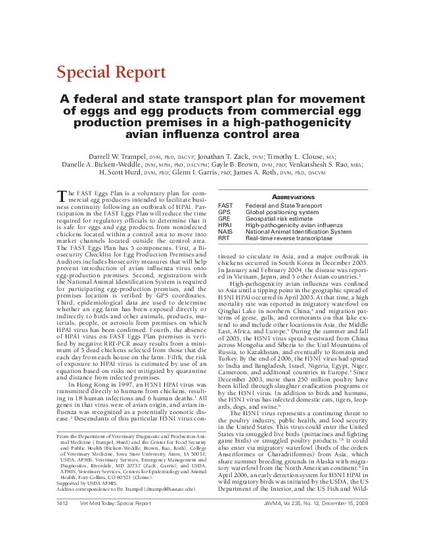
Article
A Federal and State Transport Plan for Movement of Eggs and Egg Products from Commercial Egg Production Premises in a High-Pathogenicity Avian Influenza Control Area
Journal of the American Veterinary Medical Association
Document Type
Article
Disciplines
Publication Version
Published Version
Publication Date
12-1-2009
DOI
10.2460/javma.235.12.1412
Abstract
The FAST Eggs Plan is a voluntary plan for commercial egg producers intended to facilitate business continuity following an outbreak of HPAI. Participation in the FAST Eggs Plan will reduce the time required for regulatory officials to determine that it is safe for eggs and egg products from noninfected chickens located within a control area to move into market channels located outside the control area. The FAST Eggs Plan has 5 components. First, a Biosecurity Checklist for Egg Production Premises and Auditors includes biosecurity measures that will help prevent introduction of avian influenza virus onto egg-production premises. Second, registration with the National Animal Identification System is required for participating egg-production premises, and the premises location is verified by GPS coordinates. Third, epidemiological data are used to determine whether an egg farm has been exposed directly or indirectly to birds and other animals, products, materials, people, or aerosols from premises on which HPAI virus has been confirmed. Fourth, the absence of HPAI virus on FAST Eggs Plan premises is verified by negative RRT-PCR assay results from a minimum of 5 dead chickens selected from those that die each day from each house on the farm. Fifth, the risk of exposure to HPAI virus is estimated by use of an equation based on risks not mitigated by quarantine and distance from infected premises.
Rights
Works produced by employees of the U.S. Government as part of their official duties are not copyrighted within the U.S. The content of this document is not copyrighted.
Language
en
File Format
application/pdf
Citation Information
Darrell W. Trampel, Jonathan T. Zack, Timothy L. Clouse, Danelle A. Bickett-Weddle, et al.. "A Federal and State Transport Plan for Movement of Eggs and Egg Products from Commercial Egg Production Premises in a High-Pathogenicity Avian Influenza Control Area" Journal of the American Veterinary Medical Association Vol. 235 Iss. 12 (2009) p. 1412 - 1419 Available at: http://works.bepress.com/james_roth/39/

This article is from Journal of the American Veterinary Medical Association 235 (2009): 1412, doi:10.2460/javma.235.12.1412.